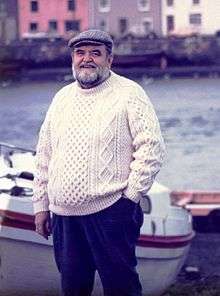Francis B. Francois
| Francis Bernard "Frank" Francois | |
|---|---|
 | |
| Born |
January 21, 1934 Barnum, Iowa, United States |
| Fields | Engineering, Elected Official, Judge |
| Institutions | AASHTO, Prince George's County, Maryland |
| Alma mater | Iowa State University, George Washington University |
| Known for | Transportation, Engineering and Policy Leadership in Surface Transportation Infrastructure and Research |
| Notable awards | W.N. Carey Jr. Award, Theodore M. Matson Memorial Award, Marston Medal, Frank Turner Medal, ARTBA Top 100 Professionals in the U.S. in the 20th Century, Washingtonian of the Year |
Francis Bernard "Frank" Francois (born 1934) is an American engineer and lawyer who has received recognition for his achievements in the field of engineering and policy leadership in surface transportation infrastructure and research. In 1999, he was elected to the National Academy of Engineering.[1]
Career
Francois grew up on a farm in Barnum, Webster County, Iowa and graduated from Iowa State University with a bachelor's degree in engineering in 1956. He moved to Washington, D.C. and began his career in 1956 as a Patent Examiner in the U.S. Patent Office. He enrolled in night law school at The George Washington University, and earned a law degree in 1960. Francois become a patent advisor for the Applied Physics Laboratory at Johns Hopkins University in 1959. He was admitted to the Maryland bar in 1960, and practiced patent and trademark law with the firm of Bacon and Thomas from 1962 until 1980.
Francois became an Elected Official in Prince George's County, Maryland, in 1962, serving first as Chief Judge of the Orphan’s Court, then a County Commissioner. After the county changed from a County Commissioner to a County Council system, he served 10 years as a member of the County Council. In this post, he represented Prince George's County on the Metropolitan Washington Council of Governments and the Washington Metropolitan Area Transit Authority boards, among many other posts. He chaired the Joint Policy Steering Committee on the Washington Metro Alternatives Analysis Project. Nationally, he was twice elected President of the National Association of Regional Councils and in 1979–1980 was President of the National Association of Counties. In 1980, he resigned from the County Council to become Executive Director of the American Association of State Highway and Transportation Officials (AASHTO) where he remained until his retirement in 1999.
In addition to leading AASHTO, Francois supported the transportation profession in many ways, including serving on the Executive Committee of the Transportation Research Board (TRB). He also served on many TRB committees, including the Task Force on Critical Transportation Infrastructure and the Committee for Study of a Future Strategic Highway Research Program. He was instrumental in establishing the original Strategic Highway Research Program and was one of the cofounders of ITS America where he served a term as its Chair and is now an honorary life member of its Board. He currently serves on the Board of Directors of Cambridge Systematics Inc. He has also served on the Board of Directors for such transportation organizations as the International Road Federation and the World Road Association.
Awards and honors
In 1973, Francois was recognized by Washingtonian Magazine as a Washingtonian of the Year [2] In 1989 Francois received TRB’s W.N. Carey Jr. Award for his leadership in supporting transportation research.[3] In 1993, he received the prestigious Institute of Transportation Engineers Theodore M. Matson Memorial Award.[4] He was elected to the National Academy of Engineering in 1999.[5] In 2003, he received the Marston Medal from Iowa State University.[6] In 2004 he was named by the American Road and Transportation Builders Association as one of the top 100 private-sector design and construction professionals in the U.S. in the 20th Century.[7] In 2007, Francois was the recipient of TRB's Frank Turner Medal for Lifetime Achievement in Transportation.[8]
In 2000, AASHTO created the Francis B. Francois Award for Innovation.[9]
Patents and Basketball
Francois was also the patent attorney for two boyhood friends, Paul D. Estlund and Kenneth F. Estlund, who received U.S. Patent 4,534,556 for a break-away basketball goal. He has written a book about the experience of acquiring the patent for the invention that saved many basketball courts from having broken backboards or bent rims. The invention also likely made it easier for the NCAA to decide on the re-introduction of the slam dunk as a legal move in college basketball, after it had been banned in 1967.
Many claim the no dunk rule was implemented to keep Kareem Abdul-Jabbar from dominating the college game, but John Wooden said, in an interview to the UCLA student daily paper, "(Alcindor) didn't cause the change. The NCAA Rules Committee outlawed the dunk because of hanging on the rim, rims bending back, boards breaking and glass down." With the advent of the break-away basketball goal, this was no longer an issue.
The invention is now in widespread use in the NBA, NCAA and in high schools and playgrounds around the world.
References
- ↑ NAE Member Directory
- ↑ Washingtonian of the Year
- ↑ TRB's W.N. Carey Jr. Award
- ↑ ITE Theodore M. Matson Memorial Award
- ↑ 1999 New Members of National Academy of Engineering
- ↑ Marston Medal
- ↑ ARTBA Top 100 Professionals in the U.S. in the 20th Century
- ↑ Frank Turner Medal
- ↑ Francis B. Francois Award for Innovation
External links
- Papers of Francis Francois, Special Collections, University of Maryland Libraries
- AASHTO
- Bacon and Thomas
- Cambridge Systematics Inc.
- U.S. Patent 4,534,556 For A Break-Away Basketball Goal
- Francois, Francis B. (2008) Two Guys From Barnum, Iowa And How They Helped Save Basketball : A History Of U.S. Patent 4,534,556 : Paul D. Estlund And Kenneth F. Estlund, Inventors (ISBN 978-0615183428)